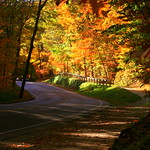Sand Run Metro Park
Overview
The 994-acre Sand Run Metro Park opened in 1929, but the area has been welcoming visitors for centuries. The land surrounding Mingo Pavilion was a campsite for Mingo Indians. Portage Path was once an important Native American trail between the Cuyahoga and Tuscarawas rivers; later, it was the western boundary of the United States. A high ridge above the Wadsworth Area was a lookout point for General Elijah Wadsworth, who made his camp near the present-day Old Portage Area during the War of 1812.
In the 1930s, Sand Run Parkway and many of the surrounding shelters and structures were constructed by the Civilian Conservation Corps. In 1974, the park district's Administrative Offices were moved here from Goodyear Heights Metro Park.
Today, visitors can drive through the ford crossing where Sand Run meanders across Sand Run Parkway. In the cool, shady ravines of Sand Run and its tributary streams, hemlocks, ferns, skunk cabbage and large colonies of horsetails grow. Each spring, large-flowered trilliums and other seasonal blooms appear, including bishop's cap, foam flower, bloodroot and pale violet.
The towering forest is home to red, gray, black and fox squirrels; screech, barred and great horned owls; and pileated woodpeckers. Red-tailed hawks roost in the treetops when they are not soaring over the ridges. Many rare species inhabit the park, including sharp-shinned hawks, butternut trees, and native orchids.
Near the intersection of Sand Run Parkway and Merriman Road is a small wetland that has become a highly productive amphibian breeding area. Every spring, the parkway is closed on nights when spotted salamanders migrate to this area for mating. The phenomenon has become a popular attraction for robust nature enthusiasts who often stand in the rain to witness hundreds of salamanders crossing the road. Other amphibians that breed in this area include spring peepers, wood frogs, American toads and green frogs.
Location:
Comments
Connections
- Akron
- Akron
- Cleveland
- Chardon
- Cleveland
- Brecksville
-
- Akron
- Cleveland
- Novelty
- AustinUnited States
- New YorkUnited States
- OaklandUnited States
- Baltimore, MDUnited States
- Cluj-NapocaRomania
- Lebanon
- CaliColombia
- New YorkUnited States
- MiltonUnited States
-
- Hong Kong S.A.R., China
- NewfieldUnited States
- OaklandUnited States
- AustinUnited States
- BaltimoreUnited States
- OaklandUnited States
- OaklandUnited States
- OaklandUnited States
- Australia
- Tillicoultry
- United States
- SwanseaUnited Kingdom
- Mechanicsburg
- ColumbiaUnited States
- United States
Multimedia
Courtesy of SaraBikes2
Impacts
No impacts have been left for this site yet - be the first!




 added by
added by 



